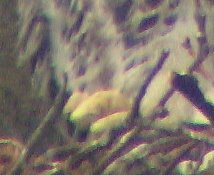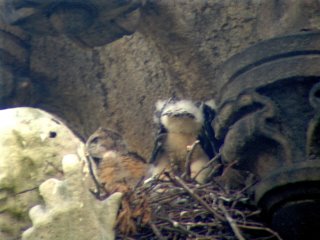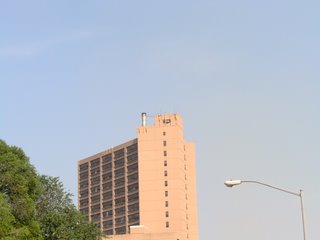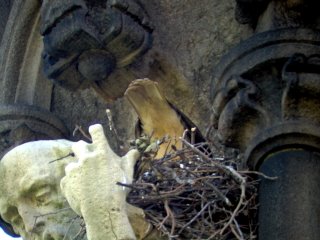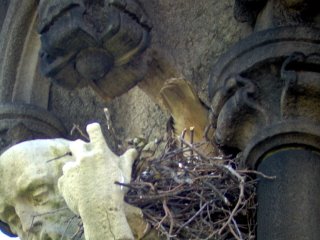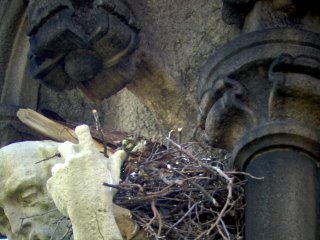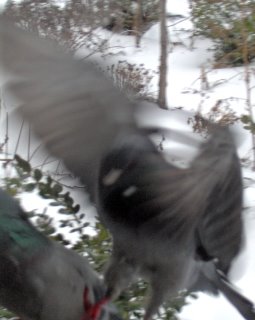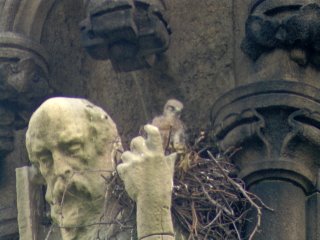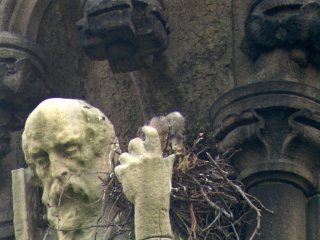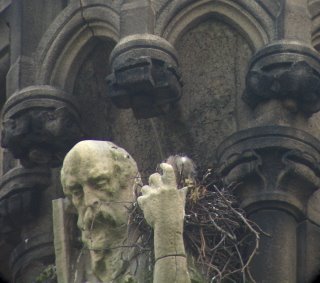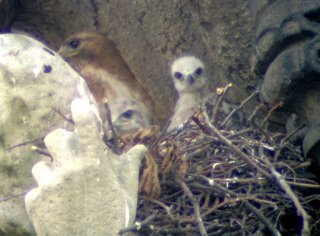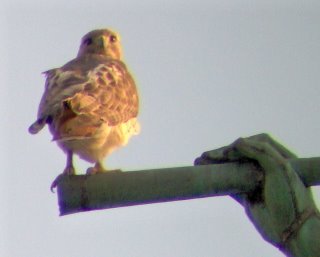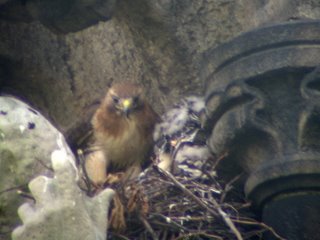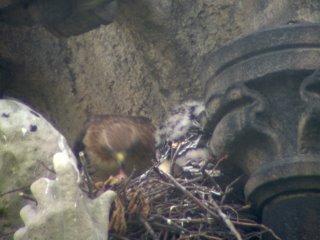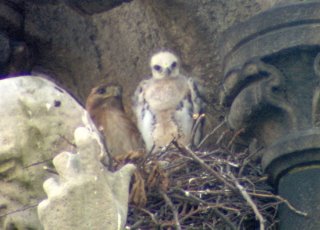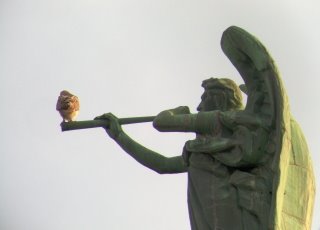 Divine Dad on his finial. Note the clenchedfoot and hidden talons.Field Notes and Photos to follow but...
Divine Dad on his finial. Note the clenchedfoot and hidden talons.Field Notes and Photos to follow but...FIRST, ATTENTION DIVINE HAWKWATCHERS WHO LIKE TO USE THE SWOROVSKI SCOPE. There is a chance of severe thunder storms this afternoon, the time when I usually have it set up at the Cathedral, therefore I'll be bringing the scope up to St. John's early in the morning instead. So come on by for a change in light and possibly behavior.
SECOND, Marie Winn, original Central Park Hawkwatcher and the author of
Red-tails In Love, the wonderful book that got many of us interested in Red-tails in the first place,
www.mariewinn.com , just forwarded an email from Karen Anne Kolling, who says...
Does Donna know she has no email link on her blog?
She is wrong about gargoyles:
"Gargoyle", the dictionary definition: a spout usually in the form of a grotesquely carved face or figure, projecting from a roof gutter. From the Old French "gargouille" and the Late Latin "gurgulio", both meaning throat. (from Chambers Concise dictionary)
Karen, Yes I'm woefully aware that my blog did not come with an encrypted email link. It is completely maddening. I have tried to add one. I haven't been able to make it work as yet. In the meantime, I have left the comments option operative on the blog, which is a way to get in touch with me. The blog emails me if a comment is left there. As to "Gargole", didn't I say, I didn't make it up, but someone else might have. Seriously though, thank you for the Chambers definition. I pulled out my Compact Oxford and my magnifying glass and yes they do eventually get to Old French, Of. gorgouille-gargola, app. especial sense of gargouille throat (e.f. Gargil, Gargle v) from the water passing through the mouths of the figures. The form gurgolyle is perhaps due to the influence of med. L. gurgulio.Divine Hawks- Field Notes 31 May 2006ALL TIMES PM UNLESS OTHERWISE NOTED.
When I arrive there is big excitement. I've just missed a battle amongst both Divine Parents and a Kestrel, Grackle, and Blue Jay, observed by James O'Brien. He 'd also seen Divine Dad eating part of a Pigeon in Morningside Park, the other part which Dad delivered to the nest observed by Stella and Clare. By the time I get there, Dad is perched on one of the fleur finials and Mom is on the nest feeding the eyasses and having a few bites for herself.
Today's Divine Hawkwatchers included James, Clare, Stella, Sylvia, Liz, Sophie, Curtis, Jean, Bruce, Norman, and John.

Look carefully at the above photo, Younger has crept up for more and is now behind St. Andrew's head.
As you'll see later in the photos, her crop is full. She's already been fed.

A light goes on in my head. I realize the mistake I made in attempting to count feeding positions when I did. By the time I began observing this nest, two eyasses were already mobile and were readily changing positions during feeding. I've just watched Divine Mom feed in at least six positions. The eyasses are shifting like crazy behind the scenes, not just figeting, and undoubtedly were, though to a lesser extent, when I counted in the first place. Lesson learned? Counting feeding positions to get a possible handle on the number of eyasses can only be done right after hatching.

Younger gets closer to Mom and the food as she
feeds someone else.
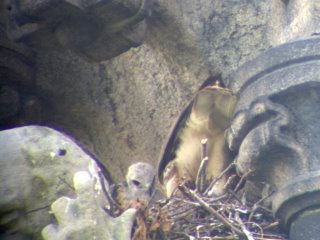
Younger gets MORE. I didn't notice it at the time
but look at how big her crop is already in the next
photograph.
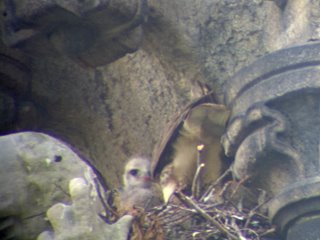
5:30 Mom is off the nest and flies N.
5:31 Eyass head appears and comes to edge of nest.
Younger steps up with what looks like a large
snowball stuck to her chest. Her crop is stunningly
full. Just a few moments ago she was
creeping up to Mom and the dinner like she
hadn't gotten any.

Younger turns and disappears into nest.
And here comes Eldest, her crop is so full that her new, therefore more sparse gold breast feathers, allow the stretched skin to show.
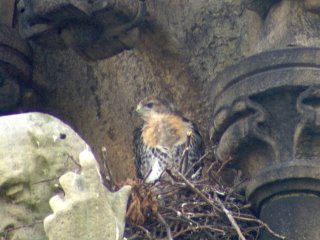
Stella points out, " It's
Divine Bigness."

5:40 I discover Divine Mom on the southeast corner of the chimney of the Margaret J. Plant Pavilion across the street, on the corner of Morningside and 113th.
5:49
The Hunt for Number ThreeA number of days ago, a group of watchers reported a third eyass in the nest. And as I've been watching the nest for a number of weeks and have never seen all three eyasses at the same time, I'm still figuring I must have seen all three at one point or another but just didn't know it. I have a plan. At this age of maturation, everyone mobile, the singles and duos I've observed would reasonably have contained all the eyasses in the nest, right? Just at different times. They've just looked so similar I didn't realize I was seeing all three.
Very young eyasses look like shmoos, as Marie Winn pointed out last season. They are white balls of fluff with black eyes, hard to tell apart. Who can tell individuals apart who are dressed in white fluff? But now that differentiating markings are starting to appear in their soon to be fledgling feathers, I should be able to tell the differences and even if my timing continues to be rotten in seeing them all three lined up together, I should be able to identify them enough to know I've positively seen all of them. (When I scrutinized the photo I have, that I
thought contained all three eyasses, the "third eyass" in the back turned out to be a decorative bit with strange light. Sigh.)
Therefore I enlisted some of the other afternoon hawkwatchers to keep an eye peeled on the full nest to make sure we saw everyone who was "see-able" today and knew the difference between them.
5:49 Sylvia who has gone over to observe the east end of the nest, calls to me. There is an eyass standing in the front between St. Andrew's head and his arm. I run over to see.

Wait just a minute. This bird has a part down the middle of her head. That's different from what I've seen previous in the day. My eyes glued, I will the eyass to move so I can see her spots more clearly.

Front Eyass turns and disappears and a moment later Sylvia calls again. An eyass has appeared on the west side of the nest. I run over.
Look at her head, she has the same part down the middle of her head feathers where the brown ones haven't as yet grown in. This is Front Eyass. This must be The Third. Alright!
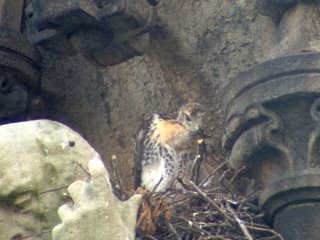
Unfortunately when she bends over a few seconds later and the light changes, her "part" disappears. I look carefully at her spotting in a previous photo of the day. This isn't The Third after all. It's Eldest. Drat.
5:58 Mom is still on chimney across the street.
6:17 Blue Jay flies into immediate area of the
nest and lands in short Tree of Heaven.
6:45 Mom flies to Gabriel and lands. Dad is still
on his fleur finial.

6:59 Divine Mom arrives and perches on the 9th step down from the apex of the "barrel" of the Cathedral.
7:07 Eldest seems to have found a leftover snack in the nest and is eating it.
7:21 Divine Dad finally puts both feet on his perch.
7:30 Various bird calls heard, including Blue Jays from south of nest.
Are the neighborhood birds gearing up for another multi-species hawk attack?
Investigation provides the answer. One of the Cathedral's blue peacocks is sitting on the Cathedral's back fence and the native birds don't like it one bit.
7:32 Mom is still on her step and Dad his finial. They have been flanking the nest very closely, for an extended period of time. Exit.
As opposed to the behavior of the parents during the last few days, today's behavior, at least after the battle, is closed ranks double defense.




